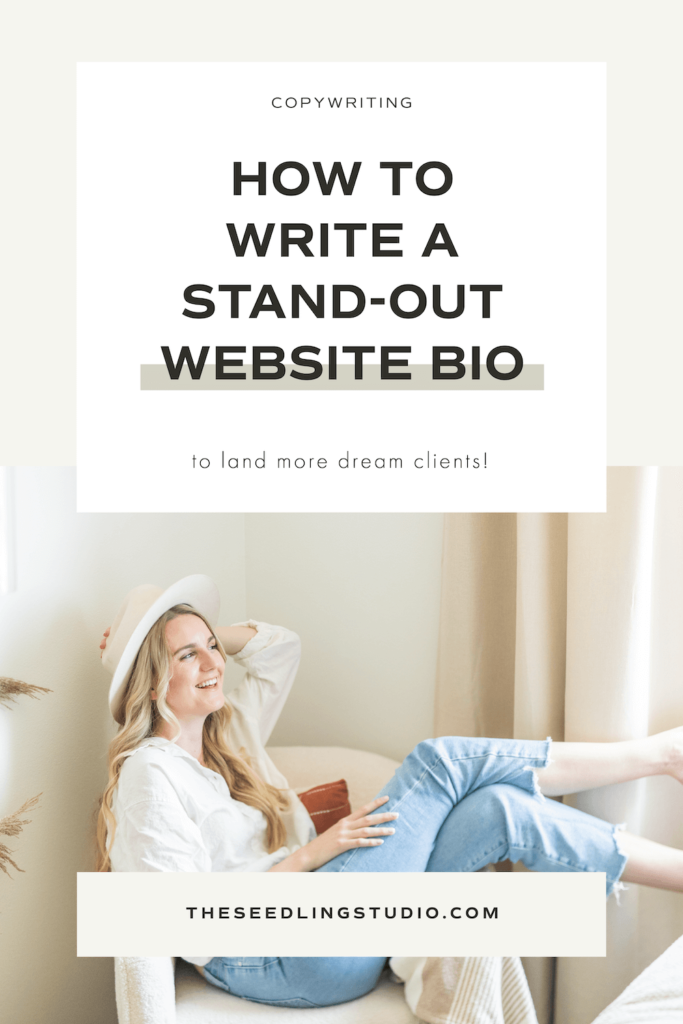Figuring out how to write a website bio doesn’t have to be hard! The bio or “about me” section of your website is one of the most underrated places to build trust and connection with your audience.
These days, we’re seeing more and more “me-focused” brands crop up – businesses that read more like personal brands than professional companies. And while there’s nothing wrong with being the face of your business, it’s easy to forget that people want to know what your business can do for them.
A big mistake people tend to make when writing their website bios is to make it all about themselves. “Hold up,” you might be thinking. “Isn’t my bio supposed to be about me?”
Yes and no!
Your bio should absolutely tell your story. But there’s a way to tell that story that connects with your audience and makes them feel like the main character. Keep reading to find out how to write a website bio that is waaay more than filler content!

How to Write a Website Bio – 3 Easy Tips to Connect with Your Clients
Your website bio should be more than just a random collection of fun facts about you. It should be a story!
We humans love a good story. It’s one of the primary ways we feel connected, especially when we see ourselves in parts of another person’s story.
Great website bios are simply great stories. And what makes a great story?
You were probably given the answer to this question in your kindergarten class: all great stories have a beginning, middle, and end. You can employ this simple three-part framework (with a little tweaking) to make writing your website bio a piece of cake.
Before you write any story, it helps to have an idea of what the point of the story is. Why are you writing this bio in the first place? The whole goal of a website bio is to build up the “know, like, trust” factor with your audience.
When people get to know, like, and trust your brand, they’ll become more likely to spend their hard-earned money with you. Your website bio is one of the best places to kickstart that journey.
The Problem/Promise: Before Your Business Started
To start, think about what life was like before you decided to start your business.
Chances are, you didn’t pull your business idea out of thin air. There was some set of circumstances in your life that led you to wonder about it.
Most businesses solve problems. So, what was it like to experience or recognize the problem before there was a solution (your business)?
If your business sells something that’s more of a luxury than a problem-solver, then you can reframe that question like this: what was it like to experience or recognize the potential for yourself or others before you came up with your business idea?
Whether you own a coaching business or an e-commerce store, your product or service moves people from Point A to Point B. Right now, your ideal customers are sitting at Point A, wondering how to get to Point B.
The beginning of your story is an ideal place to get on your audience’s level and to show them you understand what it’s like to be where they are, at Point A.

This is one of the best opportunities you have to differentiate your brand from the competition. Even if countless other businesses are offering the same solutions as your business, you are the only person who has your particular background.
Here are a few kick-starter questions to help you brainstorm this first phase of your website bio:
- What specific challenges or desires did you face before your business started?
- What specific challenges or desires did you witness other people experiencing related to your business?
- How did these challenges or desires impact other areas of your life?
- What would have happened if you’d continued experiencing this problem or desire?
The Spark: When You Experienced a Change
At this point, you’ve identified with your audience and have shown that you understand the position they’re in. The next phase of your story should be a brief explanation of how you began to experience a transformation in your life or business.
Whether it was one quick “Aha!” moment or a years-long process of discovery, give people some insight into how your business took shape.

As a heads-up, this is typically the point at which we start comparing our own stories to other people’s journeys. It can be tempting to look around and think, “Wow, so-and-so has a better personal connection to her business than I do,” or, “That person made such a big shift in her industry.”
Listen – everyone’s entrepreneurial journey is different. It’s ok if you didn’t have one big, impactful moment that changed everything for you (real life rarely happens that way!). I encourage you to keep your eyes on your own paper and stay focused on your story.
Here are some questions to get you writing about this “in-between” phase:
- Describe what it was like to find a solution to the problem you (or the people around you) were facing.
- (For brands that aren’t necessarily problem-solving:) Describe what it was like to have an answer to the desire you (or the people around you) were experiencing.
- What was the catalyst for this transformation?
- Did this change involve multiple phases? If so, what were they?
The Resolution: How Your Business Solves the Problem or Fulfills the Promise
The end of your website bio is where you can explain how your business fulfills the need or promise from the beginning of your story. After reading it, people should be able to see a clear arc from their problem or desire to the solution you’re offering.
It’s important to remember that your story isn’t over! It’s still in progress, just like everyone else’s. So, don’t feel pressured to wrap up every loose end in a neat little bow. People are attracted to authenticity, and they don’t necessarily want to learn from someone who has everything perfectly figured out.

Just because you’ve gotten to Point B, there may still be a Point C or Point D that you haven’t yet reached. Remembering this and touching on it in your copy can help you relate to your audience even more.

While the former two sections explain why you created your business, this final section describes how your business is fulfilling its mission. As your business continues to grow and change, this part of your website bio likely will, too.
Here are a few questions to get you thinking about the ending of your website bio:
- How have you been able to use your past experiences, wins, and failures to create the business we see today?
- What kinds of results have you been able to achieve for your clients or customers since starting your business?
- How has your story informed your brand’s values?
- In what ways do you hope to serve people in the future?
Now, you know how to write a website bio that captivates and connects with your ideal clients!
If you follow these tips, your website bio will do more than just tell your audience some random information about you. When people click over to your About page, they’ll be sure to find a story they can see themselves in, and they’ll start getting to know, like, and trust your brand that much more.
Stuck staring at a blinking cursor?
Download the FREE Homepage Copywriting Guide and get unstuck!




